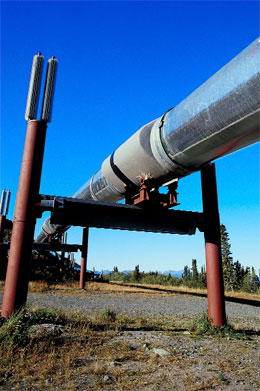|
Marketing
Energized producers
Commodity pricing drives oil & gas market
By Dave Willis
Less than six months ago, crude oil prices peaked near $150 a barrel. December 2008 saw prices dip towards $40. Some analysts see $20 or $30 a barrel before spring 2009. Others expect leveling or a modest increase.
The recent price drops, although welcomed by consumers, have wreaked havoc on oil and gas firms’ plans and activities. Other factors affect the business, too. “Hurricane Ike had an impact on premiums and will affect coverages, particularly those with offshore exposures,” says David Barclay, Dallas-based vice president and U.S. petroleum manager for Chubb’s Energy Resource Specialty. “Credit market restriction will reduce funding for drilling new oil and gas ventures, too.”
Fluid business
When commodity prices were high, firms drilled as fast as they could. “Eighteen months ago you could land at DFW and wouldn’t see any oil rigs,” says Dick Davis, senior vice president and Dallas branch manager for London American Risk Specialists, an independently owned and operated wholesale brokerage. “Now, it looks like Christmas trees all over the place.”
Recent price drops have not had as dramatic an effect—yet. “A lot of drilling is planned ahead of time,” notes Marc Jensvold president and owner of M.D. Jensvold & Co., a Houston-based MGA. Signs of pull-back are surfacing, though. “We’ve gotten early reports that drilling activities could drop by 30% in ’09,” Barclay explains.
Adds Jensvold, “They’ll be curtailing the more expensive wells— the deeper ones.” Businesses that overpaid on contracts and for equip-ment during the run-up may have problems, notes Nick Shoop, a broker at London American’s Dallas office.
Related products, such as ethanol and biodiesel, are part of the mix. “We insure a biodiesel plant in East Texas that uses soy beans, cotton and other products,” Jensvold says. “We’re seeing more of that, but on a pretty small scale.”
Gas—a cleaner fuel—continues to enjoy popularity. “A lot of power plants work on gas,” Jensvold says. “It’s cheaper to drill for.” In Wyoming alone, thousands of coal bed methane gas wells have been drilled, with thousands more in the works. “These are relatively shallow—under 3,000 feet. They can go in and set up production facilities pretty quickly.”
Considerable land-based gas drilling has occurred on the Barnett Shale in the Fort Worth area and Pennsylvania’s Marcellus Shale. “Both allow gas production closer to the customer,” Barclay notes. While this may reduce costs, there’s a downside. “With population centers nearby, there’s greater chance for third-party claims.”
Insurance issues
Oil and gas insurance pricing has been soft. “There’s no shortage of oil and gas insurance markets,” Jensvold says. “There are plenty of players, plenty of capacity.” Adds Shoop, “We’ve seen a broadening of terms. Rates have been decreasing.”
With the commodity price run-up, receipts rose, leading to higher premiums. “That’s been a great insulator for us,” Shoop adds. But growth brought challenges. “Until the recent downturn, the rapid expansion of operations was dizzying,” Barclay notes. “Communicating quickly with insurance buyers was a challenge for many agents, particularly those whose clients were exploring a wide swath of the United States or working internationally. Also, as insureds were growing, they were adding employees quickly. Good agents were busy helping with safety education and advice.”
Amid the growth, oil and gas concerns paid closer attention to insurance issues. “Major oil producers are being much more strict about subcontractor insurance require-ments,” notes Dallas-based Art McDevitt, CPCU, vice president-energy risk division of U.S. Risk, a managing general agency and surplus lines wholesaler. “Five years ago, they’d sign a master service agreement that required certain coverages and not really pay much more attention to what they had. Today, many of the majors have people on staff or employ services to check subcontractors’ policies.”
Of course, changing economics in the oil and gas business affect insurance—something agents and brokers must address. Perhaps as pressing as any is the fact that as payrolls and receipts drop, so will premiums.
Another issue is equipment valuation. “There are rigs dating back to the 1920s that have been totally rehabbed and are being put into use because they couldn’t make new ones fast enough,” says Shoop. “There are so many ways to look at replacement cost, ACV, market value, OLV, functional equivalent. Even with good appraisals, depending on the oil and gas market, we could see considerable fluctuation during the policy year. We need to know ahead of time what will happen in case of loss.”
Agent response
While agents and brokers face issues, opportunities exist, too. For instance, now is a good time to review and upgrade coverages. “You may have to transfer the business,” notes Davis, “but now’s a good time to look at that.” Shoop notes, “The current carrier may have broadened coverage and not made the offer because the agent didn’t ask.”
Consider ancillary or service business as potential markets. “You’re going to see agents working with customers who go in and service wells as they get older, who perform maintenance of all kinds, taking care of tanks and pipes and gauges,” Jensvold explains. Once the big drilling companies pull out, they turn work over to local service companies.
“We also write a lot of ancillary services—firms that rent things, for instance,” he adds. “Say a major driller is going to come in and drill a well in a fairly remote area. They need all kinds of stuff—light towers, forklifts, water tanks, backhoes, man lifts, even porta-potties.” These providers represent potential growth areas for retail agents and brokers.
It’s important to develop and demonstrate industry expertise. “The agents with the greatest success in this business are those that truly became students of the oil and gas industry,” explains Barclay. Adds Shoop, “Agents need to understand the operations they’re seeking to cover, whether they study on their own, take classes or hire an expert—an oil and gas producer—away from someone else.”
They also need oil and gas insurance know-how. “Agents need to know the markets, the available products, and give their insureds every possible option, allowing the insured to decide on the best mix of coverage and price,” Shoop adds.
Most agents partner with market experts. “Retailers depend a lot on wholesale firms like ours,” Davis says. “We’re getting calls from agents we’ve not dealt with before—retailers that don’t have oil and gas staff.” Some of these agents have investments in oil and gas and like the idea of serving the market. Others have relationships that bring them in. Still others simply view it as a market with good long-term prospects.
Agents tap carrier and MGA resources as they build expertise. “We’ve developed an Oil & Gas 101 training session that I’ve presented six or seven times to agencies around the country this year,” says McDevitt. “It gives a ‘Readers’ Digest’ version of the business, what to look for in an account, what different classes of business do, to familiarize them with accounts they’re calling on.”
The unknown
Little is certain in oil and gas. Over the coming months, consolidations and asset liquidation may occur. The push for oil independence and a quest for alternative energy sources must be balanced with strong environmentalist sentiments.
One thing is sure: The business is not for the faint of heart. It’s not for dabblers, either. “Most of these insureds can spot a phony,” Shoop notes.
Much depends on commodity pricing. “I’ve had some insureds say they can still make money where we’re at,” Davis notes. “Others are definitely slowing down.”
McDevitt adds, “They’ve shown they can make money at $50 a barrel.” Smart agents and brokers can, too.
The author
Dave Willis is a New Hampshire-based freelance insurance and business writer and regular Rough Notes contributor. |
|
| |
 |
| |
“Until the recent downturn, the rapid expansion of operations was dizzying. Communicating
quickly with insurance buyers was a challenge for many agents.”
—David Barclay
Vice President-U.S. Petroleum Manager
Chubb’s Energy Resource Specialty
|
| |
 |
| |
“You’re going to see agents working with customers who go in and service wells as they get older, who perform maintenance of all kinds, taking care of tanks and pipes and gauges.”
—Marc Jensvold, President
M.D. Jensvold & Co.
|
|